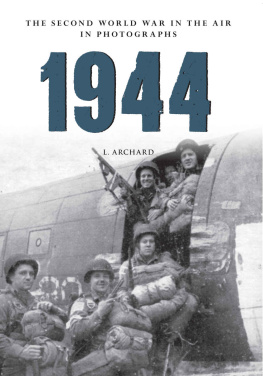First published 2015
Amberley Publishing
The Hill, Stroud
Gloucestershire, GL5 4EP
www.amberley-books.com
Copyright L. Archard, 2015
The right of L. Archard to be identified as the Author of this work has been asserted in accordance with the Copyrights, Designs and Patents Act 1988.
All rights reserved. No part of this book may be reprinted or reproduced or utilised in any form or by any electronic, mechanical or other means, now known or hereafter invented, including photocopying and recording, or in any information storage or retrieval system, without the permission in writing from the Publishers.
British Library Cataloguing in Publication Data.
A catalogue record for this book is available from the British Library.
ISBN 9781445622514 (PRINT)
ISBN 9781445622743 (eBOOK)
Typesetting and Origination by Amberley Publishing.
Printed in Great Britain.
Contents
Acknowledgements
I would like to take this opportunity to thank John Christopher for making images of the Me 262 from his collection available to me for this book.
Introduction
The war in the air in 1944 began much as 1943 had ended as the RAF bombing campaign against Berlin that had begun in November 1943 continued. On 20 January, for example, Bomber Command dropped 2,300 tons of bombs on the German capital. On the Italian front, January saw the British Armys X Corps along the Garigliano River, at the western end of the Gustav Line, a German defensive position constructed across the width of the Italian peninsula. The town of Cassino, and the historic Benedictine monastery that overlooked it from the top of the mountain of Monte Cassino, was a key point in the Gustav Line. Allied officers were convinced that the Germans were using the abbey as an observation point to direct their artillery fire onto the attacking troops. On 15 February, 142 B-17 Flying Fortresses as well as Mitchell and Marauder bombers dropped more than 1,100 tons of high explosive and incendiary bombs onto the abbey. The rubble created by the bombing and the artillery fire that was also directed onto the abbey made it an ideal defensive position for the German fallschirmjger, regardless of whether they had been occupying it previously. It would be May before the Battle of Monte Cassino was finally over.
The week of 2025 February was Big Week for the USAAF, a series of bombing missions flown largely by the Eighth Air Force in Britain, but also by the Fifteenth Air Force from its bases in Italy. Throughout 1943, the Eighth Air Force had been flying missions over Germany, relying on the heavy defensive armament of the B-17s and B-24s to protect them from German fighters when they were out of the range of the escorting P-47s and P-38s. However, the losses, particularly in the raids against Schweinfurt and Regensburg, were unsustainable. What changed this situation was the arrival of large numbers of P-51 Mustangs, which had the range to escort the bombers to their targets and back. The losses on the Big Week raids, even when the bomber crews went back to targets such as Schweinfurt and Regensburg, were a far smaller percentage of the force than they had been before the arrival of the Mustangs.
As the fighting around Monte Cassino continued into March, the town of Cassino itself was also destroyed from the air by Allied heavy bombers. 750 tons of 1,000-lb bombs with delayed action fuses were dropped on the town in the hope that it would help New Zealand troops push the German paratroopers out.
April 1944 saw Japanese forces in China launch Operation Ichi-Go, which aimed, among other things, to capture airbases in south-western China that the USAAF had been using to stage raids by B-29 bombers against Japanese forces in China, Thailand and Burma. On 15 June, B-29s flying from airbases around Chengdu in Sichuan Province carried out the first air raid on the Japanese home islands since the Doolittle Raid of 1942 when they attacked a steel works on the southern island of Kyushu.
On 6 June, the Western Allies opened the long-awaited second front, landing at five invasion beaches along a 50-mile stretch of the Normandy coast. The invasion, codenamed Operation Overlord, was the largest amphibious operation in history, with over 150,000 men involved. Included in that total were 24,000 airborne troops, who landed behind the beaches shortly after midnight on 6 June. Over 13,000 men of the US 101st and 82nd airborne divisions landed by parachute and, later, glider behind Utah beach and around the River Douve. The paratroopers successfully destroyed bridges over the River Douve and captured the crossroads at Sainte-Mre-glise, the first town to be liberated in the invasion. This was despite problems with the marking of the drop zones and with the navigation of the transport aircraft that dropped the paratroopers, caused by heavy cloud over Normandy. On the British side, a glider assault by 5th Parachute Brigade and 7th (Light Infantry) Parachute Battalion captured Pegasus Bridge over the Caen Canal and Horsa Bridge over the Orne River. However, the British paratroopers suffered from the weather as the Americans had, being blown off course and landing too far east.
As well as the landing of airborne troops, the Allied air forces played a key role before, during and immediately after D-Day. Over 2,000 RAF and USAAF bombers attacked targets along the Normandy coast and inland from the invasion beaches at about midnight. On Utah beach, the USAAF bombers had come in at a lower altitude than they had been briefed to fly at and were able to cause heavy damage to the defences. On Omaha, by contrast, the bombers had had to delay dropping their bombs to avoid hitting the landing craft, leaving many of the defences and obstacles undamaged. Over the coming days, Allied fighter bombers and light bombers, flying from bases on the south coast of England and marked with distinctive black and white stripes on their wings and tails to prevent friendly fire from troops on the ground, flew countless missions in support of the troops on the ground and destroyed the bridges and crossroads needed by the Germans to transport reinforcements to Normandy, especially the Panzer divisions.
On 13 June, a week after the D-Day landings, and in direct response to them, Hitler ordered the launch of the first V-1 Flying Bomb against Britain; that first V-1 landed next to a railway bridge on Grove Road, in the Mile End district of London. The V-1 had been in development since the start of the war, the first test flights at the research station at Peenemnde on the Baltic coast coming in late 1942. Powered by a simple pulse jet engine, the buzzing noise of which gave rise to the nickname Buzz Bomb, the V-1 also used a simple autopilot system to control its speed and altitude. An anemometer in the nose counted down a certain number of turns (based on the prevailing wind speed) and when it reached zero a mechanism was set off that set the V-1s rudder in neutral and caused it to make a steep dive onto the target. This process cut off the power to the engine, so civilians on the ground quickly learned to listen for the buzzing sound and take cover when it stopped. V-1 attacks, against both London and targets in liberated Europe such as the Belgian port of Antwerp, would continue through the rest of 1944 and into 1945. At the peak of the V-1 offensive, almost 100 were being launched per day against the south-east of England, almost 10,000 in total. Almost 2,500 reached London, killing more than 6,000 people and injuring almost another 18,000. Antwerp was hit by almost 2,500 more V-1s. To this casualty list have to be added concentration camp inmates worked to death in the Mittelwerk underground factory at Nordhausen, where both V-1 Flying Bombs and V-2 rockets were produced between 1943 and 1945. Barrage balloons, anti-aircraft fire and manned fighters particularly the Hawker Tempest, but also P-51 Mustangs, Spitfire Mk XIVs and de Havilland Mosquitoes were all effective defences against the V-1.











